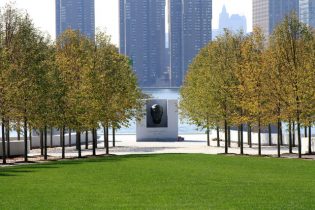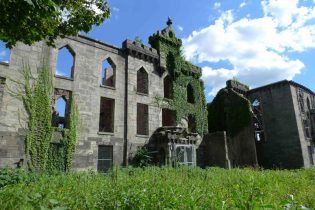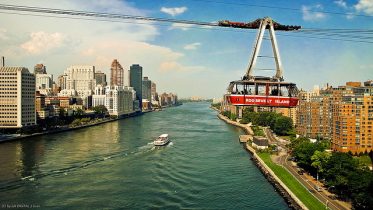


By: Hannah Kellermeyer
Today Roosevelt Island is a quaint town that is beginning to prosper. It lies in the middle of the East River between New York City and Queens. Over the past century the island has dramatically change. The Island began it history on a rocky point and continued to spiral down until the 1970. What began as a jail has shed it harsh past and blossomed into a thriving community that still has room to grow. The Island does not hide their rocky past but embraces as they look to the future.
Before Roosevelt Island became what it is today, it was called Blackwell Island named after the Blackwell family who had originally owned it. The family put there island up for sale in the early 1800’s and by 1825 it was purchased by the city of New York.[1] New York City had planned to use this small island as a prison and by 1829 Blackwell Island Penitentiary was opened. They used the prison as a working prison where the inmates were required to crush rocks in the quarry[2].The number of inmate quickly grew in size, but not with harden criminal but with men who committed misdemeanor. The island was gaining the reputation of “Welfare Island” because the people who were coming to the jail, “were sent there for less crimes and for long period of time.”[3] As the people began to fill the penitentiaries, gang began to formulate. Each of the gang began to associates with a particular ethnicity[4]. It due the influx of bribery it was not the warden who controlled the jail it was the gangs that held power with in the confines of the penitentiary. This hierarchy of the gangs continued until January 1932, when Fiorrello La Guardia took office. It was La Guardia’s goal to end corruption within the city. He started with raiding the penitentiary and transferring the convicted felons to Rikers Island, by transferring the inmates to Rikes there was no need for the island to be used as penitentiary, so the Blackwell Island Penitentiary was closed under La Guardia’s order in 1936.[5] Although it is no longer standing today the jail reminds us of the corruption that once ravaged the city. Today the penitentiary has been replaced by homes and apartments masking the troubled history that occurred on the Island.
Still standing today on the southern tip of the island lays in ruins an old hospital. Throughout the decades New York has been repurposing a hospital to fit the need of the time. The beautiful stone building is in rubles and covered in vines was once filled with people deemed too ill or crazy for society. The city built the hospital in 1839, as an insane asylum known as the “Municipal Pauper Lunatic Asylum.”[6] The hospital stood during the era of the penitentiary, many of “the patients were supervised by inmates from Blackwell Penitentiary”[7]. By having the inmates work with the mental patients we can tell that they were not getting the care the needed and were not treated with respect. At this time in history, the right held by the mentally ill were negligible. The use of inmates as workers in the asylum came from “the appropriation made to the Department of Charities and Correction for the present year is insufficient to permit the payment of salaries necessary to secure the services of trained nurses and competent junior physicians,”[8] during this time there was a lack of funding and an increase of corruption, so the money they did receive did not always go to the patients but to the pockets of the people who ran the asylum. The lack of funding allowed the inmates to work with the patients and have a “medical staff [that] is inadequate to meet the requirements of over 1,600 insane patients confined to the institution, and that the nurses examined are not qualified for the proper discharge of the important duties entrusted to them.”[9] The hiring of inadequate help reflected in the well-being of the patients, those with in the asylum. Nellie Bly used her investigation skills to go undercover as a patient to see what it was like for the patient. Bly was an undercover reporter for the “World” newspaper. In order to uncover what was occurring within the walls of the asylum, she posed as mentally insane person to be committed in to the Asylum for ten days. What she uncovered was gruesome and unthinkable. The patients were poorly treated and often times abused. The dimly light room and the sedations of the patients allowed her to describe the area as if it were a seen from a horror film.[10] The treatment of patients and the lack of equipped physician reflects on how society saw those with mental disabilities. People saw them as less of a person, which then gave them le way to hurt and miss treat the people they here supposed try to help.
The tradition of not carrying about the well-being of the patients did not last. In 1890 the “Municipal Pauper Lunatic Asylum” was converted to a Charity Hospital, which housed the “New York Training School for Nurses.” It was “the third nursing school in the United states, which helped spark an era of education and medical enlightenment.”[11] There was now a transition from treating your patients horribly to treating your patients with respect. Within the hospital the new nurses were trained on how to care for their patients properly, before the nurses can begin to work with the patients they had to go through several rounds to determine if they could qualify to be a nurse. According to the nursing manual for the school the student nurses started off as probationers where they would learn basic bed side manner and how to “shown how to make the beds, to change all soiled linen; how to remove a very sick patient from one bed to another; how to cover a patient and save her from fatigue while sitting up to have her bed made”[12] and many other task. If the student is seen as proficient she will continue on her education with in the Charity Hospital, “Should the probationer be accepted, she becomes a junior nurse and has the same kind of work for about three months.”[13] Unlike the asylum the nurses in the hospital were being well trained and equipped to handle their patients. The Charity Hospital, was meant to protect and care for the poor, it was meant for those who could not afford the high cost of visiting the doctors[14]. Furthermore, many of the patients were at the brinks of death and had very little strength. The nurses used this opportunity and skills to lift there spirts, the nurses began to focus on comfort and care of the patients.[15] The nurses would care for ten to fifteen patients at a time, although strenuous the nursing school and the way the hospital was ran showed the rest of the nation the importance of the health care profession. In 51 years the hospital was able to change its reputation of the health care services received with in the walls of the hospital. As an insane asylum the patients were harshly treated, but with the help of the new nursing school patients who might have died on their own were able to get the care they needed and deserved.
Roosevelt Island is filled with rich and exciting history. One cannot go to Roosevelt Island without noticing the sky tram. What is now a permanent fixture of the Island was not always there. Prior to the sky tram the main way of getting to the island was through the use of trolleys. A trolley would go between New York City and Queens on the Queensburo Bridge. The trolley would stop in the middle of the bridge and take an elevator down to the island. Although effective the services ended in April of 1957.[16] As time went on there was a need to figure out an easy and effective way to get the residents of Roosevelt Island on and off the island. This need to create transportation to the island only occurred once the “Urban Development Corporation” began their plans to transform the island into a residential area for middle class people[17]. James O’Kon designed the air tram as a temporary fix while the 63rd street subway was being remodeled. The date of the subway system reopening kept being pushed back and stalled so they continued to extend the amount of time the air tram would remain in use.[18] Due the extended time of the air tram, it began to grow in popularity, so they have converted it into a permanent structure. Since its opening in 1976 the Roosevelt Island air tram has carried over 26 million passengers.[19] The tram has become more than just a means of transportation, but also a means of entertainment. Many visitors take the tram to see incredible views of the city for a low cost.
When the Urban Development Corporation began plans to build a residential area, Louis Kahn began developing a park 1973 and completed the design in 1974.[20] The park was meant to celebrate “The Four Freedoms” outline in F.D. Roosevelts’ state of the union address on March 6, 1941.[21] Sadly due to financial problem with in the city, the park was put on the back burners. There were several attempt to revitalize the project, but each one failed due to lack of financial backing. In 2008, the Chicago Alphawood Foundation offered seed money that enabled the committee committed to getting this park built a project office[22]. 38 years after the designs were created Four Freedoms park opened to the public October 24, 2012[23]. The park is four square miles at the tip of the island, with a focal point of a giant bronze bust of Franklin Roosevelt. Behind the Bust, are two large cement rectangles that are engraved with the “Four Freedoms” on them.[24] Leading you to the bust is a garden with tree lining the sides. Kahn described the design of as the garden as a “gathering of nature”.[25] Khan believed that every aspect of the park had a purpose. Although it took 38 years for it to be built, the beauty and tranquility that radiates from the park was well worth the wait.
From its New York take over Roosevelt Island’s history has had several ups and downs. Over the past century we have seen the island grow from a gang riddled penitentiary to a wonderful community where anyone would be lucky to grow up in. Through examining the history of the island we can see how mankind has progressed and how we have attempted to deteriorate corruption. What was once a hospital that abused and missed treated their patients, blossomed into a hospital that helped the ill and the poor and taught the students to be better nurses than the past ones that walked the same hallways that they once did. Furthermore, we see the progress of engineering. When New York first bough the island the idea of an air tram was not feasible, and today it is an icon for the island. The Four Freedoms park remind visitor of the progress we have made and pushes society to extend the freedom so that they become universal. Roosevelt Island is continually progressing with the times and as society changes the Island will do its best to reflect those changes.
Bibliography
Berdy, Judith. “The Rocky History of Roosevelt Island.” Politico Magazine. June 13, 2015. Accessed November 10, 2016
This gives a brief history of what has occurred on the Island since New York bought the island to present day.
“Behind Asylum Bars” and “Inside the Madhouse” – Nellie Bly – New York World.” “Behind Asylum Bars” and “Inside the Madhouse” – Nellie Bly – New York World | Undercover Reporting. Accessed October 05, 2016.
This is a collection of Nellie Blys articles she published, I focused on the ones where she describes her time undercover in the insane asylum on Roosevelt Island.
Broome, Beth. “Set in Stone New York City.” Architectural Record 200, no. 10 (October 2012): 125. Academic Search Complete, EBSCOhost (accessed December 10, 2016
This journal allowed me to see the struggle that went on to gain the funding for the park.
“Key Facts: The Park.” Franklin D. Roosevelt Four Freedoms Park. Accessed December 10, 2016.
I used the actual parks website to see ow the park and rec services describe the park.
Kahn, Louis I., and Alessandra Latour. 1991. Louis I. Kahn: writings, lectures, interviews. New York: Rizzoli International Publications.
I use Khan’s own word to determine his reasoning behind his architectural decisions for the park and how he set it up. (Primary)
Stevenson, Karen. “1890: Life for Nurses and Patients in Charity Hospital, NY.” 1890: Life for Nurses and Patients in Charity Hospital, NY | ElderWeb. Accessed November 10, 2016.
This source goes over a pamphlet of what the nursing student would have to do if they were to attend the college. (primary)
The History of the Roosevelt Island Tramway | 6sqft.” 6sq Ft. May 17, 2016. Accessed November 10, 2016.
This article went through how the tram way was developed, giving me background knowledge on how it came to be.
[1] Berdy, Judith. “The Rocky History of Roosevelt Island.” Politico Magazine. June 13, 2015. Accessed November 10, 2016.
[2] IBID
[3] IBID
[4] IBID
[5] Berdy, Judith. “The Rocky History of Roosevelt Island.” Politico Magazine. June 13, 2015. Accessed November 10, 2016.
[6] “Behind Asylum Bars” and “Inside the Madhouse” – Nellie Bly – New York World.” “Behind Asylum Bars” and “Inside the Madhouse” – Nellie Bly – New York World | Undercover Reporting. Accessed October 05, 2016.
[7] Berdy, Judith. “The Rocky History of Roosevelt Island.” Politico Magazine. June 13, 2015. Accessed November 10, 2016.
[8] “Behind Asylum Bars” and “Inside the Madhouse” – Nellie Bly – New York World.” “Behind Asylum Bars” and “Inside the Madhouse” – Nellie Bly – New York World | Undercover Reporting. Accessed October 05, 2016.
[9] IBID
[10] IBID
[11] Berdy, Judith. “The Rocky History of Roosevelt Island.” Politico Magazine. June 13, 2015. Accessed November 10, 2016.
[12] Stevenson, Karen. “1890: Life for Nurses and Patients in Charity Hospital, NY.” 1890: Life for Nurses and Patients in Charity Hospital, NY | ElderWeb. Accessed November 10, 2016.
[13] Stevenson, Karen. “1890: Life for Nurses and Patients in Charity Hospital, NY.” 1890: Life for Nurses and Patients in Charity Hospital, NY | ElderWeb. Accessed November 10, 2016.
[14] IBID
[15] IBID
[16] “The History of the Roosevelt Island Tramway | 6sqft.” 6sq Ft. May 17, 2016. Accessed November 10, 2016.
[17] Broome, Beth. “Set in Stone New York City.” Architectural Record 200, no. 10 (October 2012): 125. Academic Search Complete, EBSCOhost (accessed December 10, 2016).
[18]“The History of the Roosevelt Island Tramway | 6sqft.” 6sq Ft. May 17, 2016. Accessed November 10, 2016.
[19] IBID
[20]Broome, Beth. “Set in Stone New York City.” Architectural Record 200, no. 10 (October 2012): 125. Academic Search Complete, EBSCOhost (accessed December 10, 2016).
[21] “Key Facts: The Park.” Franklin D. Roosevelt Four Freedoms Park. Accessed December 10, 2016.
[22] Broome, Beth. “Set in Stone New York City.” Architectural Record 200, no. 10 (October 2012): 125. Academic Search Complete, EBSCOhost (accessed December 10, 2016
[23] “Key Facts: The Park.” Franklin D. Roosevelt Four Freedoms Park. Accessed December 10, 2016.
[24] IBID
[25] Kahn, Louis I., and Alessandra Latour. 1991. Louis I. Kahn: writings, lectures, interviews. New York: Rizzoli International Publications.
The following photo caption is partially incorrect:
“Picture is the ruins of the ‘Municipal Pauper Lunatic Asylum.’ It can be found before entering the Four Freedoms Park”
It is actually the ruins of the “Smallpox Hospital” just north of the FDR Four Freedoms Memorial Park at the island’s southern tip.
The “Lunatic Asylum” entrance tower is now the grand entrance to the Octagon apartments, located mid-island on the west side.